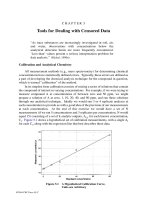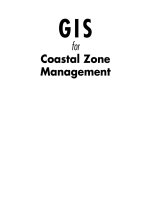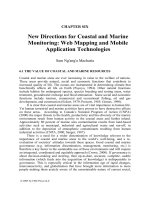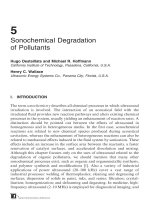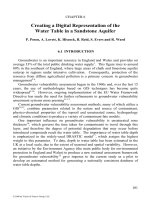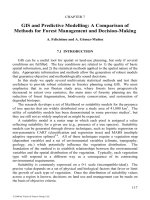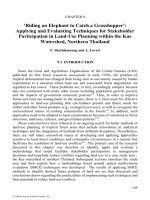GIS for Environmental Decision Making - Chapter 5 ppsx
Bạn đang xem bản rút gọn của tài liệu. Xem và tải ngay bản đầy đủ của tài liệu tại đây (1.02 MB, 22 trang )
Part II
___________________________________________________________________
Tools to Support Decision-
Making
© 2008 by Taylor & Francis Group, LLC
79
CHAPTER 5
GIS and Environmental Decision-Making:
From Sites to Strategies and Back Again
R. MacFarlane and H. Dunsford
5.1 INTRODUCTION
Spatial policy and planning are fundamentally about locating facilities, services,
industry, housing, utilities and other land uses that are required by society and the
state in such a way that benefits are justified against the foreseen costs. Many
policies have a spatial dimension in that economic activities tend to cluster, and
similar social groups exist in proximity to each other, so benefits and costs, for
instance through the collapse of heavy industry, are unevenly distributed in space.
However, spatial policies and land-use plans are much more explicitly about where
things should be. There are ‘winners’ and ‘losers’, with NIMBYism representing
one response when the ‘losers’ are proposed to be ‘here’ rather than ‘there’. If
policy is premised on achieving the greatest good (taking a wholly apolitical
perspective!) and minimizing harm, we are left with the problem that Locally
Unwanted Land Uses (LULUs) have to go somewhere and there can be opposition
in almost every direction. Alternatively, environmental decision-making may be
concerned with the allocation of scarce resources that are desired in a number of
places. Public funding for regeneration, amenity or conservation associated
investments such as woodland planting, access enhancement, wetland creation or
‘re-wilding’ schemes
1
may be subject to what is in effect a bidding process,
attempting to ‘win’ the proposed development or other measures. This might be
described as NIMBYism without the N. In neither case of course are positions
going to be universally held within any given community or locality, for instance in
the case of wind farms where the landowner and development company may be
united in their support, against the wishes of other local stakeholders. Determining
which options are ‘best’ lies at the core of environmental decision-making.
This chapter draws on research and consultancy experience for a range of
organizations in the UK. These include projects on wind energy, community forests
and the mapping of tranquillity
2-7
. The experience spans what might be
simplistically identified as a divide between ‘development’ and ‘conservation’
interests, enabling us to offer a commentary on some of the values that are often
implicit, and sometimes explicit, in what may generally be termed environmental
decision-making.
© 2008 by Taylor & Francis Group, LLC
80 GIS for environmental decision-making
Conducting these studies has provided the authors with a viewpoint on a range
of issues and debates which are pertinent to the application of GI and GIS to
environmental decision-making at the policy and planning levels. Planning is used
here in a relatively broad rather than a technically specific sense, focusing primarily
on regional and sub-regional scale activities such as Regional Spatial Strategies
8
and sectoral policies such as the Regional Forestry Strategies
9
. Land-use planning
within the statutory framework of Town and Country Planning is not the primary
focus, although many of the issues are equally relevant and applicable at that level
given the hierarchically consistent nature of the system, further tightened up with
recent revisions
10
.
A number of key themes are elaborated in the next section. This is followed by
a review of several projects and the chapter concludes with a discussion that draws
out some lessons learnt from them and their implications for research and practice.
5.2 BACKGROUND: KEY THEMES
Broadly speaking, there are different kinds of information (including GI) used
in decision-making and different stages at which they may be sought or created:
• Background: various sources, experiences, networks and the media
• Exploratory: sought out, more structured and categorized
• Analytical: selected, a focus on defensibility
• Confirmatory: related to formal evaluation to confirm decision or to
retrospectively support a position adopted.
Information is thus central to the social processes of arriving at and defending a
position. However, if the information was unequivocal, if the evidence base was
not open to challenge, if variable interpretations of the available data and
information did not have the power to carry people to different conclusions, there
would be no problem and no literature on the subject. More to the point, there
would be uniformity and consensus instead of dispute, challenge and opposition.
The convention is that both planning, taken in the broadest sense, and organized
opposition needs to be ‘evidence-based’ to be effective. Evidence-based (good)
practice is a key element in the lexicon of the current government, but evidence can
be constructed and construed in many different ways. What then is the role of
information, including GI, in environmental policy and planning? To answer this it
is important to review, although in summary, some different views on the nature of
planning and the role of technical information in support of it.
Early models of planning were procedural, systematic, rational and apolitical –
things happened in a process that had a beginning and an end point, and where all
options were considered on the basis of the available information, before selecting
or making an optimal decision. Over time these have been challenged and replaced
© 2008 by Taylor & Francis Group, LLC
Strategic and site-based planning 81
with models that emphasize the nature of planning as a more interactive,
communicative activity.
Figure 5.1 illustrates the sequential, procedural model of planning and in each
of its stages information plays a distinctive role. The name of the stage appears at
the top, what happens during this phase is in [square brackets] and the role of
information is in (brackets).
Figure 5.1 The role of information in the sequential model of the planning/policy cycle (after Danziger
et al.
11
, Barkenbus
12
, and Stephenson
13
).
Stephenson
13, p241
, commenting on the sequential, procedural model, noted that
‘the notion of a process where information is collected, a choice of policy is made,
the policy is adopted and then implemented was too simple when compared with
reality, where the process was far more messy’, yet it is an approach that is publicly
adhered to as good practice.
Campbell and Masser
14, p153
critically observe that ‘much of the folklore
surrounding computers endows them with the capacity to compensate for the
inadequacies of human intellect … and [that] this sentiment is reflected in much of
the current writing about geographic information technologies’. Klosterman
15, p47
builds on this, arguing that ‘planning practice … takes current technology largely
as given and moulds planning to fit the technology … [something] … that is
particularly relevant to the current fascination with GIS among planning
academics and practitioners’. GIS, it could be argued, has the potential to reinvent
planning as an applied science with its emphasis on locations that are optimized on
the basis of data describing defined parameters and criteria. However, this would
be naïve as the literature has developed an extensive critique of the neutrality of
evidence and indeed the neutrality of planning. The planning as communication
and planning as reasoning models
15,16
are essentially premised on the contested
nature of planning processes and their outcomes, and they embed a more inclusive
© 2008 by Taylor & Francis Group, LLC
82 GIS for environmental decision-making
approach, at least to some degree, in the planning process. In turn GIS applications
are developing to accommodate these new models, and the planning as reasoning
together approach has underpinned the emergence of the grandly titled
‘participatory geographic information science’.
‘This surge of interest in collaborative spatial decision-making in particular,
and participatory decision-making more generally has been spurred on … by
the realisation that effective solutions to spatial decision problems require
collaboration and consensus building… [which] require the participation and
collaboration of people representing diverse areas of competence, political
agendas, and social interests’
17, p2-3
.
So, attempting to briefly summarize the literatures on planning, opposition,
information and GIS:
• There is a geography to the impact of developments;
• There is a geography to the opposition to developments;
• Models which seek to rationally identify optimal locations have been
discredited by many authors (e.g., Pickles
18
) and GIS have been re-cast as
decision support tools;
• In spite of the above, GIS retains substantial credibility as a planning tool,
and the emergent literature on participatory applications of ICTs in general
and GIS in particular has established a tool for communicative planning
(e.g., web-based mapping) and reasoning together models.
• It is questionable whether reasoning together moves us forward, however
much the process is facilitated by evidence, new media and participatory
digital frameworks for debate.
This chapter relates our experience to these issues and problems, based upon a
series of case studies that all involved the Centre for Environmental and Spatial
Analysis (CESA) at Northumbria University. Cutting across these we can identify
a change in focus away from individual site proposals to regional or national
frameworks which explicitly articulate objectives and establish priorities in a
spatial form. Admirable as the latter can be, the problem remains that
developments have to actually go somewhere specific. This engenders a need for
strategic policies to mesh with more local frameworks to guide individual proposals
to actual locations that satisfy (or perhaps more accurately, address) the various
demands that the state, the developer, local communities and other interest groups
have in relation to the planned activity and the site.
© 2008 by Taylor & Francis Group, LLC
Strategic and site-based planning 83
5.3 CASE STUDIES
5.3.1 Scottish Natural Heritage: Landscape Capacity Assessment for Wind
Energy
The remit of Scottish Natural Heritage (SNH) is primarily to secure the
conservation and enhancement of Scotland’s unique and precious natural heritage.
In keeping with their role SNH commissioned pilot studies to provide a strategic
view of the scope for onshore wind energy developments in four selected districts.
It was explicitly stated by SNH that these studies were not to identify suitable
locations, but were to provide frameworks that could be used to minimize
environmental impacts, as well as guiding developments to the most appropriate
landscapes. It was also intended that the four studies would independently develop
and apply a methodology to achieve this objective.
We were involved in the study for the Western Isles
2
which utilized three key
methods:
1. An existing landscape character assessment was refined and adjusted to
accommodate detailed physical and perceptual criteria associated with
small (domestic) and large-scale (commercial) wind turbine developments.
2. Visibility analysis was carried out to derive ‘scores’ for relative visibility
across each landscape unit and for turbines of varying heights.
3. A stakeholder study was used to assess the values associated with the
types of landscape identified in the landscape character assessment.
Guidance on the conduct of landscape character assessment
19
and for evaluating
the impacts of development on the landscape and visual resource of a particular
location
20
was used alongside renewable energy policy documents
21-23
to inform an
approach to landscape capacity assessment. In total 15 Landscape Character Types
(LCTs) were identified in the study area. After considering the sensitivities and
locations of individual LCTs, a basic distinction was made as to whether each LCT
could accommodate domestic or commercial windfarms, based on a subjective but
informed understanding of levels of habitation. A landscape capacity was then
attributed to each LCT, ranging in five categories from low to high ability to
accommodate development. The resulting product took the form of a table and a
series of maps with information provided for different types of windfarm in each
LCT. The output was not spatially disaggregated to specific LCT parcels, even
though the intervisibility analysis techniques used were well suited to this, and
consequently the information presented was strategic in nature
5.3.2 Welsh Assembly: Strategic Assessment for Wind Energy Developments
In March 2002, the Welsh Assembly Government (WAG) commissioned Arup
Consultants to carry out research that would assist with updating existing planning
© 2008 by Taylor & Francis Group, LLC
84 GIS for environmental decision-making
guidance on renewable energy in the form of a Technical Advice Note (TAN 8)
24
.
CESA were sub-contracted to develop constraint criteria within a GIS in order to
identify ‘strategic search areas’ capable of delivering WAG renewable energy
targets by 2010.
The criteria for the identification of strategic areas were initially developed by a
steering group consisting of Arup staff and WAG officials. These criteria were
categorized as being either technical (practical limitations to windfarm siting; wind
speed, slope, Ministry of Defence requirements etc.) or environmental (landscape
designations, nature reserves etc.). The criteria were compiled into separate layers
in a GIS and assigned into three distinct categories:
• Absolute Constraints. Those which, for all intent and purposes (at the all-
Wales level), would be likely to prevent large-scale wind energy
developments.
• Second Degree Constraints. Factors likely to inhibit the development of
large wind energy developments but for which there was either a) some
variability/uncertainty in their spatial extent or b) the possibility to
develop inside the area concerned with appropriate mitigation.
• Positive Development Siting Factors. Characteristics which, in general,
were likely to be viewed positively for large scale wind developments by
the wind industry (e.g., single landownership, reasonable accessibility and
relatively simple land cover)
3
.
Identification of strategic areas then involved the following three steps:
1. An initial screening exercise. Absolute and second degree constraint data
(both environmental and technical) were overlaid with grid capacity
information in a GIS to determine suitable areas.
2. A refinement exercise. The areas identified were subject to a more
detailed review at 1:50,000 scale. Specific features such as access,
isolated residential properties, land availability and ownership were taken
into account.
3. Testing and validation. Analyses of visibility from National Parks, Areas
of Outstanding Natural Beauty, National Trails, existing (or approved)
wind-farms, and landscapes ‘wild’ in character were combined with
details of wind speeds and the scale of development possible to further
refine boundaries which extended 5 km either side of the perimeters for
each strategic area.
Seven strategic areas were identified at the end of this process and TAN 8 was
publicly launched in March 2004, with a subsequent review published in July
2005
24
. Inevitably, TAN 8 also resulted in studies commissioned by local
© 2008 by Taylor & Francis Group, LLC
Strategic and site-based planning 85
authorities within the strategic areas to assess on a site by site basis the most
suitable ‘zones’ within their territories. In one case this suggested a higher capacity
in a strategic area, which in turn fed back into a review of national targets for
renewable energy. A key point therefore is that because the initial strategic study
took no account of administrative boundaries, the onus was placed on local
authorities to fund studies in order to assess suitable sites for windfarm
development.
5.3.3 North East Renewable Energy Strategy
In November 2002 the Government Office for the North East commissioned
The Northern Energy Initiative, CESA and the Landscape Research Group at the
University of Newcastle to prepare a Regional Renewable Energy Strategy
(RRES). The need for this activity stemmed from a review prepared by the Cabinet
Office Policy and Innovation Unit in February 2002 which recommended that
regional planning bodies should give greater prominence to energy issues in
regional planning guidance and become pro-active in planning for energy
developments at a sub-regional level
25
. The pre-existing North East Regional
Energy Group (NEREG), whose members spanned regional bodies, local
authorities, developers and conservation interests, became the project steering
group.
To support the development of the RRES, a wide range of digital maps were
combined through a ‘sieve mapping’ approach
26
in a GIS to identify where
windfarms could not be located. Many of the datasets were unanimously accepted
by all parties on the steering group, including factors such as topple distance from
A-roads and exclusion from designated nature conservation sites or on the basis of
low wind speed. Amongst these accepted factors were GIS-based calculations of
radar line of sight. In essence, both civilian and military radar can be compromised
if any part of a rotating blade can be ‘seen’ by the radar array. The Ministry of
Defence (MoD) is particularly assertive about this and adhered to a policy that no
turbines were permissible within 74 km of a radar array where there is line of sight.
There is no weighting or gradation of this opposition by distance; it is a black/white
issue. As the military are not obliged to release technical information in support of
their position (in itself a core requirement of transparent public sector working) and
they have a critical role in policy, planning and siting decisions (which may be
loosely summarized as having the power of veto) this is an absolutely critical input,
yet it was not subject to close questioning in private meetings or at the closed
committee stages of the process. In addition, although the line of sight calculations
were carefully executed, and the results closely checked by re-running a sample of
them, they contained two potential sources of error. Neither of these was hidden in
any way during the process.
Firstly, no account was taken of known vertical error levels in the Ordnance
Survey Panorama
27
terrain model used in the calculations, since this was not
© 2008 by Taylor & Francis Group, LLC
86 GIS for environmental decision-making
regarded as having a serious effect on the results. Secondly, although the MoD
have a stated position of not having wind turbines located in line of sight from their
radar installations, they would not inform the study group of the precise
geographical coordinates and height above ground level of the radar arrays at
Brizzlee Wood and Fylingdales. Through a careful process of estimation these
locations were identified and the calculations then run on these parameters. As the
study was strategic rather than focused on tactical siting of individual turbines, the
implications are unlikely to have been in any way significant, but the absence of
any critique is the key point.
In contrast to the perceived ‘scientific’ evidence represented by the radar
calculations (see extract in Figure 5.2a), another input layer consisted of a map of
landscape sensitivity, the vulnerability of landscape character to change (Figure
5.2b). This sensitivity was assessed by considering the physical and perceptual
characteristics of landscapes with respect to different forms of wind energy
development
28
.
Figure 5.2 ’Hard’ and ‘soft’ GI for an area in North Northumberland.
Landscape sensitivity is an intrinsically more complex and contested concept
than radar visibility. In the latter the visible (unacceptable) and non-visible
(acceptable) zones were sharply delineated and there was no argument with them,
even though there are grounds to challenge the results as outlined above. It was
clear from the earliest presentation of the landscape sensitivity assessment,
however, that the results were not acceptable to some of the stakeholders. Both the
radar and the landscape analyses drew on ‘expert’ input, but the much ‘softer’
© 2008 by Taylor & Francis Group, LLC
Strategic and site-based planning 87
nature of the sensitivity assessment process caused a series of conflicts in the
committee discussions. In essence there were three stages to this:
• Competing ‘expert’ views on the approach;
• Competing ‘expert’ views on the results;
• As a consequence of the above, disquiet from ‘non-experts’ on the
committee on the nature of the information being presented.
The latter was perhaps most illuminating in the private committee meetings during
which one wind energy developer, who had little to contribute to the discussion
around the results themselves, was aghast at the realization that this was a map,
using a numerical scale to display relative sensitivity and therefore suitability,
which was (a) based on human judgement, and (b) wholly contingent on
judgements that, when revised, could result in a different map. This second
characteristic was something that was no more or less true of all the other map
layers included in the exercise, for instance the decision to exclude National Parks
but not Green Belts, an entirely social judgement. In such adversarial debates the
authority of the sources/experts and the decision criteria become critical,
illustrating how conflicts over the principles and details of spatial policy
formulation are not simply confined to developers vs. planners or planners vs. local
pressure groups.
5.3.4 North East Community Forests: A Regional GIS for Decision Support
North East Community Forests (NECF) commissioned a study to provide a
framework for the future planting and sustainable use of community woodlands
5
.
There were two key elements in the context for this study:
• The reorientation of community forests towards a more broadly based, less
tightly spatially defined, approach to countryside management in the urban
fringe;
• The explicit direction from government that new woodlands, and the
management of existing woodlands, should take as their primary focus the
potential for social benefit, through landscape enhancement, recreational
opportunities, strengthened regional images and improved quality of life.
The first of these requirements dictated that the study should be regional (North
East Government Office Region) rather than site-specific, even through realization
of a strategic plan for the region would be ultimately achieved on a site by site
basis. The second meant that the frame of reference (and consequently the data
involved) was broad ranging – this was no simple land capability study.
© 2008 by Taylor & Francis Group, LLC
88 GIS for environmental decision-making
Utilizing a 1 km x 1 km grid over the region a series of datasets were integrated
in line with the criteria defined by the steering group. The main components of the
GIS cartographic model were:
• Where people live and work. This reflected the need to target woodland
establishment and development where there are concentrations of homes
and workplaces.
• Environmental gains. Although ecological theory at the landscape scale
tends to be at the level of general principles rather than specific ‘rules’,
reducing woodland fragmentation and enhancing connectivity were
generally accepted positive objectives.
• People on the move. Targeting woodland where it had the potential to
benefit the lives of people who are travelling, for either work or leisure,
locally or through the North East. A particular factor here was the
regional image.
• Nature conservation and landscape considerations. These were not a core
component of the model, but it was accepted that there were areas where
woodlands could have a potentially negative impact on nature
conservation interests or landscape character and should therefore be
discouraged.
The principles underlying each of these factors were defined by the steering
group and with reference to a wider set of stakeholders. Articulating these
principles in a complex and differentially weighted cartographic model required
that a large number of technical decisions were made by the researchers and there
was minimal involvement in this by the steering group or stakeholders. The
researchers consistently made it clear to the steering group that decisions made, for
instance, with respect to the visibility analysis, or the distance-weighting techniques
used for population concentration, would have an impact on the model output.
Figure 5.3 shows the final map.
Although the criteria were agreed, the map underwent a process of revision
once an earlier version, which of course reflected the initially agreed parameters,
was shown to the steering group and key stakeholders. The ‘look’ of the map did
not entirely accord with their ideas of what it should look like to fulfill its policy
function. The relationship between the GI product (a map, illustrating a strategy)
and the GI process (the weighted combination of datasets to produce the map) was
therefore two-way. In simple terms it was a case of ‘do the analysis, and let’s see
what it looks like, then we can take another look at the process’, clearly spanning
the analytical and confirmatory uses of information.
© 2008 by Taylor & Francis Group, LLC
Strategic and site-based planning 89
Figure 5.3 Final suitability map for the community forests study.
5.3.5 Tranquillity Mapping
The importance, value and need to protect tranquillity is clear from a range of
policy documents, and from research on the health and social benefits to people of
being in a tranquil place
29-31
, but a systematic and robust method to document
© 2008 by Taylor & Francis Group, LLC
90 GIS for environmental decision-making
where these areas are has been lacking. MacFarlane et al.
7
were commissioned by
Campaign to Protect Rural England (CPRE) and the Countryside Agency to
develop a methodology to identify and map areas where people are more likely to
be able to have a tranquil experience. Tranquillity is an experiential aspect of what
may broadly be defined as landscape quality and assessing and mapping it poses a
series of conceptual and methodological challenges.
The concept of tranquillity mapping is not new. Several studies were
undertaken in the 1990s
32,33
, based primarily on ‘expert’ judgments of factors that
detract from tranquillity. In 2000, however, Levett
34
argued that what was needed
was a measure of tranquillity that included all, and only, those sources of
disturbance which people feel actually damage tranquillity; and which weighted
them in proportion to peoples’ perceptions of their relative impacts on tranquillity.
This is what was done by MacFarlane et al.
7
through a framework based around the
use of Participatory Appraisal (PA), an approach to consultation that focuses on
exploring peoples’ perceptions, values and beliefs, and is designed to allow
participants to discuss what is important to them, and express this in their own
words
35
. PA sessions were carried out across two study areas, the Northumberland
National Park and the West Durham Coalfield area.
After the initial PA data collection, two ‘verification’ events were held. Prior to
these meetings the responses made during the PA sessions were collated into
themes (whether they were something ‘you see’, ‘you hear’ or ‘you do’ in a
tranquil area, whether they were something ‘of the mind’, or whether they were
something ‘you do not see’ or ‘you do not hear’). People were then asked to select
their top three responses within each theme, according to their perceived level of
importance to tranquillity. These events quantitatively established the relative
importance of different factors. In consultation with the project steering group, and
with reference to published best practice, the distilled PA data were then associated
with specific spatial datasets that could be used to translate the preferences and
judgements expressed by respondents into mapped outcomes. The GIS analysis
followed a raster modelling approach in ArcGIS with a 250 m grid cell resolution.
Three main categories of data formed the basis of the GIS model. These
stemmed directly from information obtained during the PA and were as follows:
• People. In the consultation ‘people’ were associated with many kinds of
behaviors (e.g., loud noise, litter, barking dogs and noisy children) and in
some cases the very presence of people detracted from tranquillity. A
modelling approach that identified the relative likelihood of people being
in a given square was used to calculate a measure representing remoteness
from other people.
• Landscape. Variables indicating the relative amount of exposure to visual
elements (both positive — rivers, wide open views, the sea or broadleaved
woodland, and negative — coniferous woodland, light pollution) in the
© 2008 by Taylor & Francis Group, LLC
Strategic and site-based planning 91
landscape were combined with the perceived naturalness of each
individual square and the presence of rivers to generate a score for each
individual grid square.
• Noise. GIS techniques were used to model the diffusion of noise away
from sources such as roads, urban areas, railways and military training
areas. Both the maximum noise at any time and the time-averaged noise
exposure were estimated, to take account of the effect of intermittent but
very loud noises, and low but constant background noise on the experience
of tranquillity.
All of the data layers were weighted (using the PA responses) to reflect their
relative significance (e.g., remoteness from people had a much higher rating than
overhead light pollution). The positively and negatively weighted component data
sets were then separately added together, and these were then combined to produce
a total score in accordance with the relative significance of positive (0.44
weighting) and negative (0.56) factors from the PA data.
Figure 5.4 shows the overall score map and provides information that can be
used for a number of land-use and landscape planning purposes. More specifically,
the Regional Planning Guidance for the North East of England
36
states that
development plans and strategies should identify, protect and work to increase
tranquil areas. Using the methodology and maps produced by the study will assist
planners in achieving this objective.
The research also provides another illustration of the judgements that are often
involved in the generation and analysis of geographical information. GIS are tools
that are rooted in quantified and/or categorized data as representations of reality.
For over 20 years, a growing number of researchers and practitioners have begun to
question the validity of many of the assumptions and constructs used in this
representation process. This has begun to inform a growing, but still relatively
limited, body of work that seeks to bridge the ability of qualitatively-based research
to develop in-depth understandings of spatial phenomena and the ability of GIS as a
set of techniques to represent these
37
. The tranquillity mapping study contributes to
such work but, like several of the other case studies reviewed above, highlights the
need for further research on this issue.
5.4 DISCUSSION
Table 5.1 compares the five case studies on a number of characteristics. Some
broader themes arising from the studies are discussed below.
© 2008 by Taylor & Francis Group, LLC
92 GIS for environmental decision-making
Figure 5.4 Overall tranquillity score map for two study areas in the North East region. For color
versions see MacFarlane et al.
7
and
With permission.
© 2008 by Taylor & Francis Group, LLC
Strategic and site-based planning 93
Table 5.1 Comparison of case study characteristics
Theme SNH WAG NEREG NECF Tranquillity
Focus
Landscape
capacity
Regional
strategy
Regional
strategy
Forestry
strategy
Policy
Ultimate
objective
Resource
assessment
LULU
allocation
LULU
allocation
Resource
allocation
Resource
assessment
GI product
Method /
Map / Data
Map /
Method
Map
Map /
Method
Method / Map
Strategic
! Site
Strategic
Initially
strategic,
then site
Both Strategic
Primarily
strategic
Selection of
parameters
Steering
group
Expert,
informed by
steering
group
Steering
group
Steering
group and
stakeholders
Public
consultation
Review of
product by
stakeholders
Detailed and
sustained
None, but
resulted in a
consultation
document
Detailed and
iterative
Detailed and
through open
stakeholder
discussion
None
Role of GI/S
experts
Technical
advice and
method
development
Technical
advice
Established
framework
for rational
decision-
making
Managed
entire project
Managed
entire project
Latitude for
experts to
determine
details
Shared Shared
Near
complete
control
Shared
Complete
control
Overtly
political nature
of process
None Medium High Low None
Role of GI Analytical Analytical
Analytical /
Confirmatory
Analytical /
Confirmatory
Analytical
Data problems None None Significant Significant Severe
Agenda of
project
Advisory Promotional Promotional Lobbying
Lobbying /
Advisory
© 2008 by Taylor & Francis Group, LLC
94 GIS for environmental decision-making
5.4.1 The Role of Information in Decision-Making
The use of GI and GIS as analytical and communicative tools is problematic.
Checkland and Holwell, writing about information systems at large, observe that
‘what such systems cannot do, in a strict sense, is provide unequivocal information;
what they can do is process capta (selected data) into useful forms which can imply
certain categories of information. They cannot, however, guarantee that the capta
will be interpreted in this way by people making use of the system’s outputs’
38,p92
.
The simplicity of the GIGO acronym (Garbage in, Garbage Out) has been
significant in raising the profile of data quality issues, but more complex matters of
context-dependency, the contested nature of information and the often political
character of decisions are harder to distill and communicate.
The wind energy developer referred to in Section 5.3.3 appreciated the
equivocal, contingent nature of one particular input into the model (landscape
capacity), but failed to extend this appreciation to other factors where there were
questionable social judgements, such as why B-roads were excluded from having to
have a safety distance from turbines. They are less busy than A-roads but if there is
a hazard from falling turbines, people, albeit fewer of them, are still exposed to it.
This does illustrate that people have contrasting expectations of different kinds of
information, something on which the related literature on risk and science has much
to contribute.
There is no simple dichotomy between ‘hard’ information, with all its
connotations of reliability and impartiality, and ‘soft’ information, with associated
images of uncorroborated sources and corridor conversations, any more than there
are sharp boundaries between ‘safe’ and ‘hazardous’. Information is best seen as a
rather more ‘squashy’ commodity, with inescapable implications of malleability.
5.4.2 Data Availability and Quality Issues
Most GIS applications are data hungry exercises and the criteria in models such
as those outlined above have a tendency to outstrip the availability of suitable data.
Although nationally available datasets are of a generally extremely high quality in
the UK, most notably the OS range of spatial data products, the availability of
locally created datasets that can be combined for a regionally consistent picture is
often problematic. In the longer term initiatives such as MAGIC
39
promise greater
availability, consistency and quality of spatial data for environmental decision-
making, but at present such datasets are typically accorded lower priority than those
relating to regeneration in regional observatory projects.
5.4.3 The Significance of Spatial Boundaries
Planners like sharp spatial boundaries. This is quite understandable as decisions
based on imprecise spatial boundaries are as hard to make, and then defend, as
those based on imprecise criteria. For this reason areas that have associated policy
© 2008 by Taylor & Francis Group, LLC
Strategic and site-based planning 95
status and planning measures are almost universally precisely bounded, even when
underlying phenomena such as level of deprivation or landscape quality are not
satisfactorily captured in this way. Lines on maps are necessary, however
sophisticated the critique or advanced the fuzzy modelling techniques become. For
the purposes of opposing proposed developments, equally sharp boundaries are
often not required. Indeed, one current aspect of research into NIMBYism is where
the ‘backyard’ actually starts and ends. However, as a twist to this it is interesting
to note that future developments of the tranquillity mapping approach may work
towards defined zones (delineated by sharp spatial boundaries) rather than a
continuum of values. Despite a recognition that landscape quality rarely varies in a
way that can be accurately reflected in sharp boundaries, the requirements of a tool
to protect high quality landscapes demands that they are delineated in such a
manner; both development and conservation interests have a requirement for spatial
boundaries, although their location is of course a subject of debate and conflict.
5.4.4 The Often Contentious Nature of GI Processes and Products
GI products emerge through processes, with some of the latter being subject to a
sustained critique and others more widely accepted. In the case studies described,
project steering groups all had a role to play in defining, scoping, overseeing and
evaluating the GIS applications. Different steering groups played these roles in
different ways, and this may be related to the nature of the applications involved.
In the case of NEREG (Section 5.3.3) a government target had been regionalized
and the immediate context was that the North East had to accommodate ‘its share’.
The approach was therefore one of finding sites that could fulfill this target. Within
the steering group a range of interest groups was represented, from countryside
conservation groups that sought to minimize perceived damage by steering
development towards urban fringe areas on the general basis that they were already
degraded in landscape terms, through local authority staff who sought to deflect
developments away from areas that were, in their sub-regional context, the most
valuable to them, to development interests which were tightly focused on economic
imperatives. It is through such, often unhappy, marriages, that strategic plans are
created and the way in which information is used in background, instrumental,
rationalization and monitoring roles needs to be as transparent as possible.
5.4.5 The Crucial Nature of Site-Specific Analyses in the Pursuit of Strategic
Objectives
Planning, in its broadest form, is a precursor to action, defining what and where
things will take place. Spatial planning may be strategic, in which case precision
about the where is less critical, or it may be locally-specific at which level the task
is one of translating higher level aspirations and general spatial guidance, into site-
specific outcomes. These outcomes may be an absence of development (e.g.,
within a nature reserve or a green belt) or approval of proposals (e.g., for new
© 2008 by Taylor & Francis Group, LLC
96 GIS for environmental decision-making
housing or woodland), but the point is that translation from the general to the
specific is required and frameworks, tools and techniques are needed to support this
and ensure consistency with higher principles.
5.4.6 Technical Latitude in the Application of ‘Best Practice’
There is now a large body of work which seeks to establish and support ‘best
practice’ for a number of methods relevant to environmental planning and
policy
19-22,40
. These documents use a combination of site specific evidence-based
work and a general checklist of applicable methodologies to provide guidance.
However, the interpretation of these guidelines, i.e., how methodologies are
implemented, is very much up to the practitioner. Using visibility analysis as an
example (it was employed in all five case studies), the way in which parameters
were agreed, how it was used, the scale at which it was applied and how the results
were incorporated into the final product varied greatly, even when the aims were
very similar (e.g., the NEREG and WAG wind energy projects).
5.4.7 The Innately Political Nature of Environmental Policy and Planning
At a strategic level environmental policy and planning is a Political (large P)
activity in that it is conducted in line with the objectives of the elected government,
and this holds to true to a degree at the regional and local levels as well where
elected members determine the framework within which council officials operate.
Opposition is also an inherently political (small p) activity in that it is concerned
with the (spatial) allocation of resources and LULUs. Opposition groups have been
crudely characterized as NIMBYs, NIMPOOs (Not In My Period Of Office) or
CAVEs (Citizens Against Virtually Everything). Planning decisions, from the
refusal of a development control committee to allow a new extension to a single
building, through to RSSs are inherently political, and the way in which GI is
utilized to develop, build, question or support positions and decisions can be
equally politically charged or motivated.
5.5 CONCLUSION: FROM LOCAL TO STRATEGIC AND BACK AGAIN
Although strategic land use and regional planning was extremely significant in
post-Second World War Britain, the laissez faire politics of the 1980s saw it rapidly
fade. This context saw the emergence of a more ‘predatory’ role for development
interests and the relatively de-regulated landscape became increasingly subject to
urban sprawl and the diffusion of urban developments. Developers sought to secure
sites and then develop them and the ability of local government to manage this
growth within a strategic framework was limited.
Under the post-1997 Labour government, regionally-organized delivery of
public policy agendas, strategy formulation and planning has become much more
© 2008 by Taylor & Francis Group, LLC
Strategic and site-based planning 97
significant. This period has also seen a proliferation of targets for economic, social
and environmental progress, from regional to national and international in scale.
Such targets (e.g., for employment or renewable energy generation) have required
developments of different kinds; previously developed land has been re-used for
new business parks and the increasing number of site-by-site windfarm
developments have began to have cumulative impacts on certain landscapes. With
increasing emphasis on efficiency (targeting supply on areas of demand),
effectiveness (reaching targets), equity (ensuring that opportunities are available in
areas of relative deprivation) and sustainable development (balancing economic,
social and environmental factors) GIS has emerged strongly as a tool to try and
juggle the differing criteria. Many of the case studies presented in this chapter are
clear examples of such endeavors.
However, at the end of the day government, at whatever level, is not usually
directly involved in building business parks, planting trees or establishing
windfarms, and its role is largely restricted to policy formulation, strategic
planning, the design of incentive schemes and regulation. By providing strategic
direction, developers can avoid costly, lengthy and probably unsuccessful
applications in ‘the wrong area’, government is seen to be transparent and the
outcomes are more consistent with frameworks that will have been subject to public
consultation. Nevertheless, we are still left with the problem that developments
actually take shape in specific places, on actual parcels of land. The increasing
body of good practice at the strategic level must now be supplemented with GIS-
based site assessment methodologies for Local Development Frameworks and
development control planners that retain consistency with the strategic principles
and are suitably transparent and efficient in their operation. At present, it is the
private sector that is accelerating most rapidly in this respect as developers seek to
utilize GIS to retain their competitive advantage in the search for sites that are
‘right’.
5.6 REFERENCES
1.
The Wildland Network, What is wildland?, , 2005.
2.
Benson, J.F., Scott, K.E., Anderson, C., MacFarlane, R., Dunsford, H., and Turner K., Landscape
Capacity Study for Onshore Wind Energy Development in the Western Isles, Scottish Natural Heritage
Commissioned Report No. 042, ROAME No. F02LC04, Scottish Natural Heritage, Edinburgh, 2004.
3.
Arup Consultants, Facilitating Planning for Renewable Energy in Wales: Meeting the Target, Final
Report Research Contracts 105/2002 and 269/2003, Arup, London, 2004.
4.
Dunsford, H., MacFarlane, R., and Turner K., The Development of a Regional Geographical
Information System for the North East Renewable Energy Strategy 2003, North East Assembly,
Newcastle, 2003.
5.
MacFarlane, R. and Roe, M., Strategic Planning for the Development of North East Community
Forests: A GIS Study, North East Community Forests, Stanley, Durham, 2004.
© 2008 by Taylor & Francis Group, LLC
98 GIS for environmental decision-making
6.
Davies, C., MacFarlane, R., McGloin, C. and Roe, M. Green Infrastructure Planning Guide,
, 2006.
7.
MacFarlane, R., Haggett, C., Fuller, D., Dunsford, H., and Carlisle, B., Tranquillity Mapping:
Developing a Robust Methodology for Planning Support, Report to the Campaign to Protect Rural
England, Countryside Agency, North East Assembly, Northumberland Strategic Partnership,
Northumberland National Park Authority and Durham County Council, Report available at
Centre for Environmental & Spatial Analysis, Northumbria
University, Newcastle upon Tyne, 2004.
8.
Planning Portal, Regional Spatial Strategies and Regional Planning Guidance – England,
2006.
9.
Forestry Commission, Regional Forestry Frameworks,
2006.
10.
Cullingworth, J.B. and Nadin, V., Town and Country Planning in the UK, 14
th
Edition, Routledge,
London, 2006.
11.
Danziger, J.N., Dutton, W.H., Kling, R., and Kraemer, K.L., Computers and Politics: High
Technology in American Local Governments, Columbia University Press, New York, 1982.
12.
Barkenbus, J., Expertise and the policy cycle, Unpublished paper, Energy, Environment and
Resources Centre, University of Tennessee, 1998.
13.
Stephenson, R., In what way, and to what effect is technical information used in policy making?
Findings from a study of two development plans, Planning Practice & Research, 13, 237-245, 1998.
14.
Campbell, H. and Masser, I., GIS and Organisations, Taylor & Francis, London, 1995.
15.
Klosterman, R., Planning Support Systems: a new perspective on computer-aided planning, Journal
of Planning Education and Research, 17, 45-54, 1997.
16.
Orland, B., Budthimedhee, K., and Uusitalo, J., Considering virtual worlds as representations of
landscape realities and as tools for landscape planning, Landscape and Urban Planning, 54, 139-148,
2001.
17.
Jankowski, P. and Nyerges, T., Geographic Information Systems for Group Decision Making, Taylor
and Francis, London, 2001.
18.
Pickles, J., Ed., Ground Truth: The Social Implications of Geographic Information Systems, Guilford
Press, New York, 1995.
19.
Countryside Agency and Scottish Natural Heritage, Landscape Character Assessment: Guidance for
England and Scotland, CAX 84, Countryside Agency, Cheltenham, 2002.
20.
Landscape Institute and Institute of Environmental Management & Assessment, Guidelines for
Landscape and Visual Impact Assessment, 2nd Edition, Spon Press, London, 2002.
21.
Scottish Executive, Planning Advice Note 45: Renewable Energy Technologies. Revised. Scottish
Executive, Edinburgh 2002.
22.
Scottish Natural Heritage, Strategic Locational Guidance for Onshore Wind Farms in Respect of the
Natural Heritage, Policy Statement 02/02, Scottish Natural Heritage, Edinburgh, 2002.
23.
Department of Trade and Industry, Future Offshore – a Strategic Framework for the Offshore Wind
Industry, Department of Trade and Industry, London, 2002
24.
Welsh Assembly Government, Technical Advice Note (TAN) 8 Renewable Energy, Welsh Assembly
Government, Cardiff, 2005.
© 2008 by Taylor & Francis Group, LLC
Strategic and site-based planning 99
25.
The Northern Energy Initiative, North East of England Regional Renewable Energy Strategy.
Summary Report and Input to Regional Planning Guidance, Report to the North East Assembly RSS
Forum 28th March 2003, North East Assembly, Newcastle, 2003.
26.
Heywood, I., Cornelius, S., and Carver, S., An Introduction to Geographical Information Systems, 3rd
Edition, Pearson, Harlow, 2006, 282.
27.
Ordnance Survey, Land-Form Panorama
®
,
products/landformpanorama, 2006.
28.
Benson, J., Scott, K., and Anderson, C., Landscape Appraisal for On-Shore Wind Development,
Consultation Draft Report (Part), 11th March 2003. Report to North East Renewable Energy Group,
Landscape Research Group, Newcastle University, 2003.
29.
Hartig, T., Mang, M., and Evans, G. W., Restorative effects of natural environment experiences,
Environment and Behaviour, 23, 3-26, 1991.
30.
Mace, B. L., Bell, P. A., and Loomis, R. J., Aesthetic, affective, and cognitive effects of noise on
natural landscape assessment, Society and Natural Resources, 12, 225-242, 1999.
31.
Morris, N., Health, Well-Being and Open Space Literature Review, OPENspace Research Centre for
Inclusive Access to Outdoor Environments, Edinburgh, 2003.
32.
Council for the Protection of Rural England and the Countryside Commission, Tranquil Areas –
England Map, Council for the Protection of Rural England, London, 1995.
33.
Association for the Protection of Rural Scotland, Mapping Tranquillity in Scotland (Inverness to
Aberdeen): Concept, Methodology and Potential, Association for the Protection of Rural Scotland,
Edinburgh, 2000.
34.
Levett, R., A Headline Indicator of Tranquillity: Definition and Measurement Issues, Interim Report
to CPRE by CAG Consultants 7 July 2000, CAG Consultants, London, 2000.
35.
Chambers, R., The origins and practice of Participatory Rural Appraisal, World Development, 22,
953-969, 1994.
36.
Government Office for the North East and the Office of the Deputy Prime Minister, Regional
Planning Guidance for the North East (RPG1), The Stationary Office, London, 2002.
37.
Bell, S. and Reed, M., Adapting to the machine: Integrating GIS into qualitative research,
Cartographica 39, 55-66, 2004.
38.
Checkland, P. and Holwell, S., Information, Systems and Information Systems: Making Sense of the
Field, John Wiley, Chichester, 1998.
39.
Multi-Agency Geographic Information for the Countryside (MAGIC),
2006.
40.
English Nature, Nature Conservation Guidance on Offshore Windfarm Development,
2005.
© 2008 by Taylor & Francis Group, LLC
